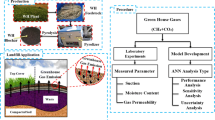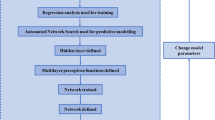Abstract
Soil compaction has contrasting effect on soil strength (i.e., positive) and vegetation growth (i.e., negative), respectively. Biochar has been utilized mostly in combination with soils in both agricultural fields (i.e., loose soils) and geo-structures (i.e., dense soil slopes, landfill cover) for improving water retention due to its microporous structure. Biochar is also found to be useful to reduce gas permeability in compacted soil recently. However, the efficiency of biochar in reducing gas permeability in loose and dense soils is rarely understood. The objective of this study is to analyze effects of compaction on gas permeability in soil at different degrees of compaction (i.e., 65%, 80% and 95%) and also different biochar amendment contents (0%, 5% and 10%). Another aim is to identify relative significance of parameters (soil suction, water content, biochar content and compaction) in affecting gas permeability. Experiments were conducted before applying k-nearest neighbor (KNN) modeling technique for identifying relative significance of parameters. Biochar was synthesized from a coastal invasive species (water hyacinth), which has relatively no influence on food chain (as unlike in biochar produced from biomass such as rice husk, straw, peanut shell). Based on measurements and KNN modeling, it was found that gas permeability of biochar-amended soil is relatively lower than that of soil without amendment. It was found from KNN model that for denser soils, higher amount of soil suction is mobilized for a significant increase in gas permeability as compared to loose soils. Among all parameters, soil suction is found to be most influential in affecting gas permeability followed by water content and compaction.








Similar content being viewed by others
References
ASTM D2487-17 (2017) Standard practice for classification of soils for engineering purposes (unified soil classification system). ASTM International, West Conshohocken. https://doi.org/10.1520/D2487-17
Bordoloi S, Garg A, Sreedeep S, Lin P, Mei G (2018) Investigation of cracking and water availability of soil–biochar composite synthesized from invasive weed water hyacinth. Biores Technol 263:665–677. https://doi.org/10.1016/j.biortech.2018.05.011
Carman PC (1956) Flow of gases through porous media. Buttervvorth Scientific Publications, New York
Damkjaer A, Korsbech U (1992) A small-diameter probe for in situ measurements of gas permeability of soils. Radiat Prot Dosim 45(1–4):85–89. https://doi.org/10.1016/j.rser.2016.06.003
DDI (Decagon Devices Inc) (2016) MPS-2 and MPS-6 dielectric water potential sensors operator’s manual. Decagon Devices, Pullman. http://manuals.decagon.com/Retired%20and%20Discontinued/Manuals/13755_MPS-2and6_Web.pdf
Fredlund DG, Morgenstern NR (1977) Stress state variables for unsaturated soils. J Geotech Geoenviron Eng (ASCE 12919) 103:447–466
Garg A, Ng CWW (2015) Investigation of soil density effect on suction induced due to root water uptake by Schefflera heptaphylla. J Plant Nutr Soil Sci 178(4):586–591. https://doi.org/10.1002/jpln.201400265
Garg A, Bordoloi S, Ni J, Cai W, Maddibiona PG, Mei G, Poulsent TG, Lin P (2019) Influence of biochar addition on gas permeability in unsaturated soil. Géotech Lett. https://doi.org/10.1680/jgele.18.00190
Gopal P, Bordoloi S, Ratnam R, Lin P, Cai W, Buragohain P, Sreedeep S (2019) Investigation of infiltration rate for soil–biochar composites of water hyacinth. Acta Geophys 67(1):231–246. https://doi.org/10.1007/s11600-018-0237-8
Jagtap SS, Lall U, Jones JW, Gijsman AJ, Ritchie JT (2004) Dynamic nearest-neighbor method for estimating soil water parameters. Trans ASAE 47:1437–1444
Jien SH, Wang CS (2013) Effects of biochar on soil properties and erosion potential in a highly weathered soil. CATENA 110:225–233. https://doi.org/10.1016/j.catena.2013.06.021
Joseph J, Kuntikana G, Singh DN (2019) Investigations on gas permeability in porous media. J Nat Gas Sci Eng 64:81–92. https://doi.org/10.1016/j.jngse.2019.01.017
Kavitha B, Reddy PVL, Kim B, Lee SS, Pandey SK, Kim KH (2018) Benefits and limitations of biochar amendment in agricultural soils: a review. J Environ Manag 227:146–154. https://doi.org/10.1016/j.jenvman.2018.08.082
Kumar H, Ganesan SP, Bordoloi S, Sreedeep S, Lin P, Mei G, Sarmah AK (2019) Erodibility assessment of compacted biochar amended soil for geo-environmental applications. Sci Total Environ 672:698–707. https://doi.org/10.1016/j.scitotenv.2019.03.417
Lehmann J, Joseph S (eds) (2015) Biochar for environmental management: science, technology and implementation. Routledge, Abingdon
Liu X, Han F, Zhang X (2012) Effect of biochar on soil aggregates in the loess plateau: results from incubation experiments. Int J Agric Biol 14(6):975–979
Mateus MDSCS, Machado SL, Barbosa MC (2012) An attempt to perform water balance in a brazilian municipal solid waste landfill. Waste Manag 32:471–481. https://doi.org/10.1016/j.wasman.2011.11.009
Mohareb EA, MacLean HL, Kennedy CA (2011) Greenhouse gas emissions from waste management—assessment of quantification methods. J Air Waste Manag Assoc 61(5):480–493. https://doi.org/10.3155/1047-3289.61.5.480
Nemes A, Rawls WJ, Pachepsky YA, Van Genuchten MT (2006) Sensitivity analysis of the nonparametric nearest neighbor technique to estimate soil water retention. Vadose Zone J 5(4):1222–1235. https://doi.org/10.2136/vzj2006.0017
Ozcoban MS, Isenkul ME, Güneş-Durak S, Ormanci-Acar T, Övez S, Tüfekci N (2018) Predicting permeability of compacted clay filtrated with landfill leachate by k-nearest neighbors modelling method. Water Sci Technol 77(8):2155–2164. https://doi.org/10.2166/wst.2018.139
Pohjankukka J, Riihimäki H, Nevalainen P, Pahikkala T, Ala-Ilomäki J, Hyvönen E, Heikkonen J (2016) Predictability of boreal forest soil bearing capacity by machine learning. J Terrramech 68:1–8. https://doi.org/10.1016/j.jterra.2016.09.001
Rahman SAZ, Mitra KC, Islam SM (2018) Soil classification using machine learning methods and crop suggestion based on soil series. In: 2018 21st international conference of computer and information technology (ICCIT). IEEE, New York, pp 1–4. https://doi.org/10.1109/ICCITECHN.2018.8631943
Reddy KR, Yaghoubi P, Yukselen-Aksoy Y (2015) Effects of biochar amendment on geotechnical properties of landfill cover soil. Waste Manag Res 33(6):524–532. https://doi.org/10.1177/0734242X15580192
Saiyouri N, Bouasker M, Khelidj A (2008) Gas permeability measurement on injected soils with cement grout. Cem Concr Res 38(1):95–103. https://doi.org/10.1016/j.cemconres.2007.08.015
Valdes-Parada FJ, Ochoa-Tapia JA, Alvarez-Ramirez J (2009) Validity of the permeability Carman–Kozeny equation: a volume averaging approach. Physica A 388(6):789–798
Wong JTF, Chen Z, Ng CWW, Wong MH (2016) Gas permeability of biochar-amended clay: potential alternative landfill final cover material. Environ Sci Pollut Res 23(8):7126–7131. https://doi.org/10.1007/s11356-015-4871-2
Yang Y, Aplin AC (2010) A permeability–porosity relationship for mudstones. Mar Pet Geol 27(8):1692–1697. https://doi.org/10.1016/j.marpetgeo.2009.07.001
Zolfaghari AA, Taghizadeh-Mehrjardi R, Moshki AR, Malone BP, Weldeyohannes AO, Sarmadian F, Yazdani MR (2016) Using the nonparametric k-nearest neighbor approach for predicting cation exchange capacity. Geoderma 265:111–119. https://doi.org/10.1016/j.geoderma.2015.11.012
Acknowledgements
The authors would like to acknowledge the National Natural Science Foundation (NSFC) Youth Project (Grant number 41907252) and also Shantou University Scientific Research Fund (NTF17007), China.The first and fourth authors would also like to acknowledge International Collaboration Fund from Academic Melting Pot Program (KREF206237) from King Mongkut’s Institute of Technology Ladkrabang (KMITL).
Author information
Authors and Affiliations
Corresponding author
Ethics declarations
Conflict of interest
On behalf of all authors, the corresponding author states that there is no conflict of interest.
Rights and permissions
About this article
Cite this article
Garg, A., Huang, H., Kushvaha, V. et al. Mechanism of biochar soil pore–gas–water interaction: gas properties of biochar-amended sandy soil at different degrees of compaction using KNN modeling. Acta Geophys. 68, 207–217 (2020). https://doi.org/10.1007/s11600-019-00387-y
Received:
Accepted:
Published:
Issue Date:
DOI: https://doi.org/10.1007/s11600-019-00387-y




